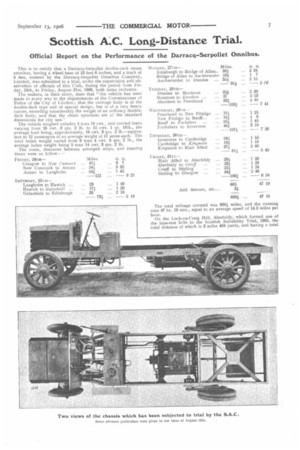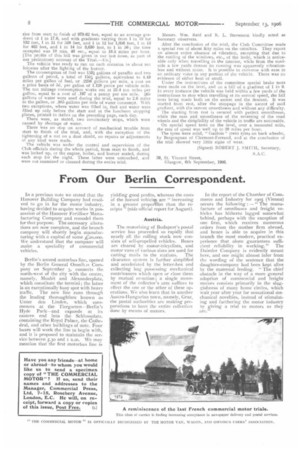Scottish AC. Long-Distance Trial.
Page 7

Page 8

If you've noticed an error in this article please click here to report it so we can fix it.
Official Report on the Performance of the Darracq-Serpollet Omnibus.
This is to certify that a Darracq-Serpollet double-ceck steam omnibus, having a wheel base of 13 feet 6 inches, and a track of 5 feet, entered by the Darracq-Serpollet Omnibus Company, Limited, was submitted to a trial, under the supervision and ob. servation of officials of this Club, during the period from Friday, 24th, to Friday, August 31st, 1906, both dates inclusive. The makers, in their entry, state that "the vehicle has been made in every way to the requirements of the Commissioner of Police of the City of London; that the carriage body is of the double-deck type and of special design, but is of a very heavy nature, exceeding considerably the weight of an ordinary double. deck body, and that the chain sprockets are of the standard dimensions for city use."
The vehicle weighed unladen 4 tons 18 cwt., and carried loads varying from 26 cwt. 3 qrs. 2 lb. to 12 cwt. 1 qr. 181b., the average load being, approximately, 16 cwt. 3 qrs. 2 lb.—equivalent to 12 passengers of an average weight of 11 stone each. The total laden weight varied from 6 tons 4 cwt. 3 qrs. 2 lb., the average laden weight being 5 tons 14 cwt. 3 qrs. 2 lb. The route, distances between arranged stops, and running The total mileage covered was 6881 miles, and the running time 47 hr. 19 min., equal to an average speed of 14.5 miles per hour. On the Loch-na-Craig Hill, Aberfeldy, which formed one of the time-test hills in the Scottish Reliability Trial, 1905, the total distance of which is $ miles 484 yards, and having a total
rise from start to finish of 979.62 feet, equal to an average g a• deent ef I in 17.6, and with gradients varying from 1 in 10 tor 132 feet, 1 in 11 for 1)28 feet, and I in 12 for 1,056 feet, 1 in 13 for 462 feet, and 1 in 14 for 3,630 feet, to 1 in 50; the time occupied was 18 min. 40 sec., equal to 10.5 miles per hour. [The profile of this hill was given in our last issue, as part at our preliminary account of the 'Fria:I.—Fn.]
The vehicle was ready to run on each occasion in about ten Minutes after the lighting of the burner.
The consumption of fuel was 153* gallons of paraffin and two gallons of petrol, a total of 1552, gallons, equivalent to 4,43 miles per gallon of fuel, or .2256 gallons per mile, a cost on a price basis of 5c1. per gallon of 1.128 pence per vehicle mile, The ton mileage consumption works out at 25,4 ton miles per gallon, equal to a cost of .197 of a penny per ton mile. 1-1/i> gallons of water were used during the trial, equal to 2.6 miles to the gallon, or .385 gallons per mile of water consumpt. With two exceptions, where water was filled in, fuel and water were filled up only before the start and at the luncheon stopping places, printed in italics on the preceding page, each day. There were, as stated, two involuntary stops, which were caused by shortage of water, There was no stop on account of mechanical trouble from start to finish of the trial, and, with the exception of the tightening of a not on a dust shield, no repairs or adjustments of any kind were made.
The vehicle was under the control and supervision of the Club officials during the whole period, from start to finish, and was locked up, or the engine, boiler, and burner sealed, during each stop for the night. These latter were untouched, and were nut examined or cleaned during the entire trial. Messrs, Wm. Reid and R. L. Stevenson kindly acted as honorary observers.
After the conclusion of the trial, the Club Committee made a special run of about fifty miles on the omnibus. They report an almost entire absence of vibration, excepting that due to the rattling of the wiedows, etc., of the body, which is noticeable only when travelling in the interior, while from the roadside a low yards distant its running was apparently vibrationless and without noise. It is possible to converse with ease in an ordinary voice in any portion of the vehicle. There was no evidence of either heat or smell.
hinder the insttuctions of the committee special brake tests were made on the level, and on a hill of a gradient of 1 in 9. In every instance the vehicle was held within a few yards of the instructions to stop when travelling at its .normal speed, the hill tests being made both on the ascent and the descent. It was started from rest, after the stoppage in the ascent of said gradient, with the utmost smoothness and without any difficulty.
'rhe starting from rest is secured with perfect smoothness, while the ease and smoothness of the reversing of the road wheels and the dirigibility of the vehicle in traffic are noticeable.
On special speed tests on the level, over a measured mile, the rate of speed was well up to 20 miles per hour.
The tyres were solid, " Gaulois" (twin tyres on back wheelst, by Bergougnan of Clermont-Ferrand, and at the conclusion of the trial showed very little signs of wear.
(Signed) ROBERT J. SMITH,
SAC.
59, St. Vincent Street, Glasgow, 6th September, 1906.


























